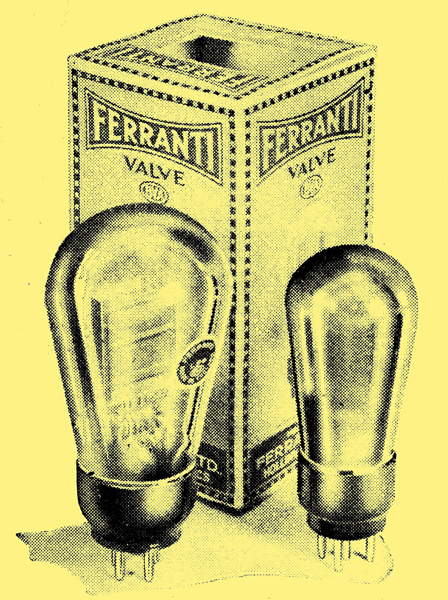|

Two Ferranti AC triodes; the D4 and the LP4.
The D4 and the LP4 appear in the Ferranti list as AC valves for in each case the filament consumption is one Amp at four Volts. Both are triode valves, the D4 being a general purpose type and indirectly heated, whilst the LP4 is a power valve with a directly heated filament. The rated characteristics of the D4 are: AC resistance, 12,500 Ω and amplification factor 41.3, giving a mutual conductance of 3.3 mA/V. Its usual function is that of a detector or oscillator in superheterodyne receivers, but it will serve equally well as the input valve in a two-stage amplifier.
The specimen D4 sent in for test when measured at 100 Volts on the anode and with zero grid bias showed an AC resistance of 14,000 Ω, an amplification factor of 39.5, and a mutual conductance of 2.8 mA/V. With the maximum anode potential of 200 Volts and the rated working grid bias of -3 Volts, its AC resistance increased to 17,500 Ω and the amplification fell to 39.1, giving a mutual conductance of 2.2 mA/V. Under these conditions the anode current was 3.5 mA. It has a five-pin base, and the price is 13s. 6d.
In view of the heavy anode current passed by the LP4 without a grid bias potential, even with but 100 Volts on the anode, it was not deemed wise to attempt measurements under these conditions, so the valve was tested only with the normal working potentials. Using the stated grid bias resistor of 750 Ω, the equivalent grid bias potential with 250 Volts on its anode was found to be -33 Volts, the anode current then being 44 mA. The measured AC resistance of the valve was 1,100 Ω, its amplification 4.65, and the mutual conductance 4.2 mA/V.
The optimum load is about 4,000 Ω, and the AC power output 2.5 Watts. It costs 16s. 6d., and the makers are Ferranti, Ltd., Hollinwood, Lancashire.
|